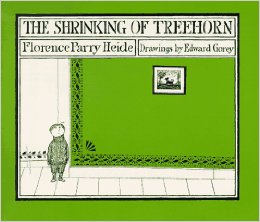Reviews of quirky kids’ books that are of interest to an adult literary crowd.
~by Dan Pinkerton
The Shrinking of Treehorn, a lime green pocket-sized paperback, can be got for around the price of a value meal from the fine folks at Amazon. The Treehorn of the title is a boy I’d guess to be eight or nine years old. His age is never given, nor do we ever learn whether Treehorn is his first or last name. The mononymous character is something of a staple of children’s literature—consider Madeline, for instance, or Sendak’s Max. Writers want character names that will stick in a young reader’s head, but a single-named character also serves another purpose. He’s not some “other,” with a set of specifics one might find on a passport. He is me; I am Treehorn, or at least could be. Many of these children’s stories share elements of fables or fairy tales where a moral is to be conveyed, and the moral cannot efficiently sink in if the reader fails to place himself in the character’s shoes.
We get our first glimpse of Treehorn on the book’s cover, courtesy of Edward Gorey, who has done the ink drawings. Treehorn stands in an unfurnished room, staring wistfully at something beyond the viewer’s range of vision. At first glance, Gorey’s drawings seem rudimentary, toss-off sketches in the same vein as Shel Silverstein’s: lines bend when they should remain straight; characters’ postures appear stilted. But as I examined the drawings more closely, I was amazed by how gestural they were, how the tilt of Treehorn’s head gave him an expression of longing, or, in another image, how his mother stooped slightly, gazing into the oven as she held a hand to her chin. Hers was a pensive look—not of concern for her son’s wellbeing but rather that the cake wouldn’t fall.
This is one of the underlying tensions of the book, an unconcern for Treehorn’s condition, which, if you haven’t already guessed from the title, is that he is shrinking. His first clue comes when he fails to reach things in his closet he was once able to—namely, his candy stash. Then Treehorn’s “trousers” appear to grow too big. I call attention to the word “trousers” because it is but one example of how the author, Florence Parry Heide, has created (with Gorey’s help) a willfully anachronistic book. The Shrinking of Treehorn was first published in 1971, but certain phrases and behaviors of its characters make it seem at least a decade older, and Gorey’s drawings make it seem older yet. Continue reading
![[PANK]](https://pankmagazine.com/wp-content/themes/pank/assets/images/pank-logo-large.png)

